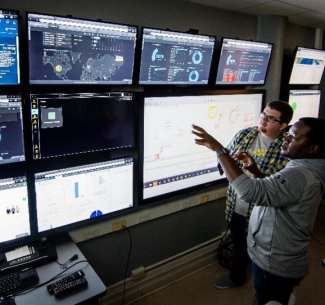The Research Cyberinfrastructure (RCi) team at South Dakota State University, offers support for high-performance computing (HPC) and high-velocity research data transfer services within the South Dakota Board of Regents (SDBOR). RCi currently manages the largest HPC platform within the SDBOR system for use by research and education throughout the state. New users of the SDBOR research community and existing users with new projects may obtain access to the cyberinfrastructure resources SDBOR HPC Project Intake. Existing users who have already completed the project onboarding process and need help with their project are asked to complete a Self Service Request for HPC Assistance.

- HPC cluster, Innovator, is part of the research cyberinfrastructure. The cluster currently provides more than 250 TFLOPS of computing capacity. Innovator runs on Rocky Linux operating system and supports over 300 open-source applications and frameworks such as R, Python, C/C++ code with MPI, TensorFlow, and a wide range of scientific packages serving engineering and life sciences research.
- RCi provides more than 65 single HPC server systems.
- Storage systems include several high-speed parallel file systems and multi-tiered storage platforms.
"Innovator" HPC cluster
The next-generation cluster has become the major tool for the computational research available for our scientific and engineering community. This cluster boasts the most advanced CPU architectures for parallel computing and acceleration of machine learning applications. The computational tasks of AI researchers and simulations gain a significant boost with the latest generation of the GPU hardware. The Innovator cluster addresses the most pressing demand for fast storage and access to a huge volume of scientific data. The key features of the computing hardware are Intel Xeon Gold 6342 CPUs, A100 GPUs and nodes with up to 2 or more TBytes of RAM.
High-Performance Research Servers
Research computing supports over 100 Linux and Windows servers in addition to the Innovator cluster. These servers provide access to resources that span all disciplines across campus. Most recently, several servers were added to provide access to bioinformatics and GPU intensive applications, for example.
- Prairie Thunder (PT) server offers 160 cores (with Hyper-Threading) and 3TBytes of RAM for non-cluster applications like CLC Genomics Workbench.
- Iris server has 160 cores (with HT) and, 3TBytes of memory with 4 NVIDIA V100 GPUs connected via NVLink that supports our Artificial Intelligence and other GPU workloads.
Hardware acceleration resources

Besides commonly found parallel computing with processes and threads, HPC cyberinfrastructure offers GPU and CPU-centric performance accelerators. The latest GPU technology is available both within the cluster environment and stand-alone servers. Differently from GPU, the CPU acceleration takes advantage of the latest generation processors. It employs the combination of the smart compilers on the specific CPU platform, both within the cluster and stand-alone parallel processing servers. Please, reach out to our team for more information on performance acceleration of your computational pipeline.
Data Storage Services
Storage and data flow planning solution services are available to enable researchers to store and share data securely in a collaborative environment.
The Team:
Management
Kevin Brandt - Assistant Vice President for Research Cyberinfrastructure
Chad Julius - Director of Research Cyberinfrastructure
Research Facing Group
Anton Semenchenko - Research High-Performance Computer Specialist (Research Facilitator)
Mohsen Ahmadkhani- HPC Software Development Engineer (Research Facilitator)
Systems Facing Group
Luke Gassman - Systems Facing Research Cyberinfrastructure Support/Communications Network Analyst
Rachael Auch - Systems Facing Research Cyberinfrastructure Support/Communications Network Analyst
Vacant Student Position - Cluster program deployment and configuration.
For more information and assistance with high-performance computing resources, please contact SDSU HPC.
GPU computing
GPU computing has proven itself as a valuable resource in accelerating computational pipelines in science and engineering. GPU offers complex techniques to boost both machine-learning applications and a series of open-source applications. Please, follow this like to find out more about how the RCi team can assist you with preparing GPU hardware and software stack to perform well for your specific goal.
Training in Research Computing
RCi team provides training and consulting in the wide range of high-performance areas. Parallel computing with cluster, GPU accelerators, scientific computing with open-source programs are among the most popular topics that RCI can provide guidance and advice.
Computing resource planning, optimization, and risk management for graduate and post-graduate research projects are a critical activity for running scientific projects toward successful finish line. RCi team actively participates in numerous R&D initiates that depend on finely tuned software and hardware. RCi offers its know-how of executing computational scientific research which we acquired over many years of engaging in the early stages of student's projects.

